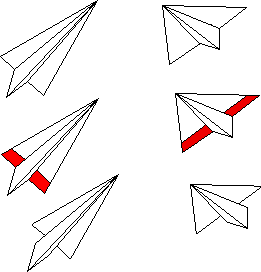
|
Design of Airfoil and Problem-Solving Using
FoilSim
Activity
|

|
If so instructed by your teacher, print out a worksheet
page for these problems.
Open
FoilSim.
Set the following conditions as
a Reference for the remainder of the activity :
|
Airspeed: 200 mph
|
Thickness: 12.5 %
|
|
Altitude: 5000 ft.
|
Camber: 0
|
|
Angle: 2.5 degrees
|
Surface area: 300 sq.ft.
|
Use FoilSim to complete the problem-solving activities that
follow:
Step 1.
Set the velocity to 50 mph and record the lift. Increase the
airspeed slider to 100 mph. Record lift. Increase the velocity to 150
mph and record lift again. Finally increase the velocity to 200 mph
and record lift. Describe the change that you observe in lift as
velocity changes. Graph lift vs. velocity.
Step 2.
Return to the Reference condition and select the "Stall Model".
Set the angle at 2.5 and record lift. Repeat, setting the angle
for 5.0, 7.5, and 10 and record lift for each setting. Graph the
results. Complete
your graph with a stall at an angle of 12. Will lift be generated at
an angle of 0? Explain.
Step 3.
Return to the Reference conditions.
Set the surface area to 100
sq.ft. Record the value for lift. Double the surface area. How is
lift affected? Record lift. Double surface area two additional times
and record lift. Graph lift vs. surface area from the data recorded.
Explain how an airplane can slow its velocity for landing and still
maintain sufficient lift to avoid a stall.
Step 4.
Return to the Reference conditions.
Set the camber at 0. Record lift. Increase camber to 6.25, 7.5,
8.75, 10.0, 11.25, and 12.5 and record the changes in lift for each
setting. Graph lift vs. camber with the data recorded.
Step 5.
Return to the Reference conditions.
Adjust the altitude slider to 15000
ft., 25000 ft., 35000 ft., and 45000 ft. and record lift at each
setting. Graph lift vs. altitude with the data collected above and
predict the next two points on the graph. Is lift affected by an
increase in altitude? List possible reasons for any changes
observed.
Step 6.
An airplane is beginning its descent at an altitude of 1500 ft. and a
beginning velocity of 200 mph. Gradually decrease altitude and
velocity and note the change that occurs in lift. Record your
observations. Explain how the lift force can be maintained while
velocity and altitude are being decreased as the airplane approaches
landing. Check your explanation using the FoilSim demonstrator.
Summarize your results.
Step 7.
An airplane travels 40,000 feet horizontally from the point where it
began its descent at an altitude of 1500 feet. Draw a diagram of the
descent showing the vertical and horizontal components, and calculate
the angle of descent for the airplane.
FOILSIM APPLICATION ACTIVITY
Design and build a paper airplane that has the longest time aloft
and travels the greatest distance.
Step 1.
Use unlined paper for your construction. Determine the wing area by
breaking areas of the wings down into triangles and rectangles.
Measure and calculate.
Step 2.
Using the same launch angle and velocity, fly your airplane through
five trials. Measure the wing surface area, distance traveled, and
angle of inclination for the wings in each trial. Make a data table
and record your results. Repeat the trial flights for time aloft.
Again, record the wing surface area, time aloft, and angle of
inclination for the wings in each trial. Graph the area/time or
area/distance data for each set of trials. The trial flights must be
completed indoors to eliminate wind effects.
Step 3.
Write a summary of your results.
Step 4.
Cut one inch off the trailing edge of the wings. Place the cut off
pieces within the folds of the airplane so the mass remains
constant.

Step 5.
Repeat the trial flights, data collection, graphing, and written
summary as above.
EXTENSION ACTIVITY
Design and construct airplanes with other wing shapes. Repeat the
steps of the preceding activity for each design. Provide a written
discussion comparing all results.
|
